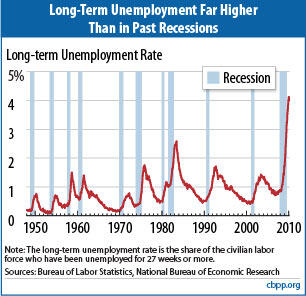Statement: Chad Stone, Chief Economist, on the February Employment Report
Today’s jobs report shows that job losses continued at a moderate pace in February and unemployment remained unchanged at 9.7 percent. While noting that these numbers may include the impacts on hiring and hours worked of the severe winter weather that paralyzed major Northeastern cities in February, the Labor Department said that it could not quantify the impact. These weather effects are transient, however, and the more important fact is that we still have a very long way to go to erase the huge jobs deficit that remains the legacy of the longest and deepest recession since the Great Depression.
Economists broadly agree that last year’s American Recovery and Reinvestment Act (ARRA) has significantly boosted economic growth and reduced unemployment compared with what would have happened without it. But forecasters are now concerned that the recovery will slow and could stall entirely without additional fiscal stimulus.[1] Today’s report reminds us why it is vital for Congress to extend the ARRA measures providing extra weeks of unemployment insurance and

At a time when many people want to work but cannot find jobs and the demand for goods and services falls well short of what businesses can supply, the key to boosting economic activity, creating jobs, and strengthening the fragile recovery is to create additional demand. Financial relief for low- and moderate-income individuals and unemployed workers who need to replace lost income does this directly. Similarly, fiscal relief for cash-strapped states reduces the amount of demand-reducing, job-killing budget cuts and tax increases that states will have to enact to meet their balanced-budget requirements. These two measures should be at the top of the list as policymakers craft a jobs package.
About the February Jobs Report
While the labor market is stabilizing after a long deterioration, conditions remain harsh for job-seekers.
- Private and government payrolls combined shrank by 36,000 jobs in February, with half of these losses coming from declines in government payrolls. Net job losses since the recession began in December 2007 total 8.4 million. (Private sector payrolls have shrunk by 8.5 million jobs over the period.)
- The pace of job losses has slowed markedly — to an average of just 27,000 per month over the past four months, compared with an average of 727,000 jobs per month over the same four months a year earlier.
- The unemployment remained at 9.7 percent in February. That, however, is still 4.7 percentage points higher than at the start of the recession.
- For the second straight month, more people entered the labor force than left it; the labor force participation rate edged up to 64.8 percent in February. The combination of an increase in labor force participation and a steady unemployment rate resulted in a slight rise in the percentage of the population with a job, from 58.4 percent to 58.5 percent. Nevertheless, both the labor force participation rate and the percentage of the population with a job remain near lows that were last seen in 1985 and 1983, respectively.
- The Labor Department’s most comprehensive alternative unemployment rate measure — which includes people who want to work but are discouraged from looking and people working part time because they can’t find full-time jobs — edged up to 16.8 percent in February. While very high, that figure is still below the 17.4 percent rate reached in October 2009.
- Long-term unemployment remains a significant concern. Over two-fifths (40.9 percent) of the 14.9 million people who are unemployed have been looking for work for 27 weeks or longer. These long-term unemployed represent 4.0 percent of the labor force, a higher percentage than at any point in the past six decades (the next highest was 2.6 percent in June 1983).
The Center on Budget and Policy Priorities is a nonprofit, nonpartisan research organization and policy institute that conducts research and analysis on a range of government policies and programs. It is supported primarily by foundation grants.
End Notes
[1] James R. Horney and Chad Stone, “Don't Let the Ideal Prevent the Necessary: Why Offsets Are Not Needed for Temporary Economic Recovery Legislation,” Center on Budget and Policy Priorities, March 3, 2010.
